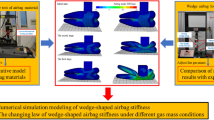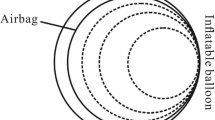Abstract
In previous studies, the numerical simulation models of industrial airbags were verified to have high accuracy regarding their actual dynamics. However, numerical methods were scarcely utilized to simulate and investigate the inflation height behaviors of nursing bed airbag. For this problem, this study constructs a numerical simulation model illustrating the association between the internal pressure and inflating height of nursing bed airbag, under various external loads. Firstly, based on an averaged pressure prerequisite, an airbag dynamic model is established by the control volume approach (the air inside the airbag follows the gas state equation of Poisson’s law). Besides, the elastic mechanical behaviors of airbag film material are determined according to a material constitutive model built by the quasi-static uniaxial tensile test. The obtained data are used as the boundary conditions, for the numerical dynamics modeling of the nursing bed airbag. Verification experiments clarify that this numerical modeling is accurate for describing airbag inflation behaviors, and then can be effectively applied to the design and optimization phases of nursing bed airbags. Based on the simulation modeling above, the mathematical equation of controlling airbag inflating height by its internal pressure is obtained. It provides a vital basis for the differentiated and intelligent control of the airbag nursing bed.
Graphical abstract













Similar content being viewed by others
References
Cortés OL, HerreraGalindo M, Villar JC, Rojas YA et al (2021) Frequency of repositioning for preventing pressure ulcers in patients hospitalized in ICU: protocol of a cluster randomized controlled trial. BMC Nurs 20(1):121–121. https://doi.org/10.1186/S12912-021-00616-0
Serrano Lima M, González Méndez MI, Carrasco Cebollero FM, Lima Rodríguez JS (2017) Risk factors for pressure ulcer development in Intensive Care Units: a systematic review. Med Intensiva (English Edition) 41(6):339–346. https://doi.org/10.1016/j.medine.2017.04.006
Rabadi MH (2021) Fever in a paraplegia patient with a pressure ulcer. Radiol Case Rep 16(9):2434–2436. https://doi.org/10.1016/j.radcr.2021.05.065
Lindqvist EK, Sommar P, Stenius M, Lagergren JF (2020) Complications after pressure ulcer surgery - a study of 118 operations in spinal cord injured patients. J Plast Surg Hand Surg 54(3):145–150. https://doi.org/10.1080/2000656X.2020.1720700
Anoop RG, Kareem JK, Murillo A, Taylor DO et al (2019) Postoperative pressure ulcers after geriatric hip fracture surgery are predicted by defined preoperative comorbidities and postoperative complications. J Am Acad Orthop Surg 28(8):1–1. https://doi.org/10.5435/JAAOS-D-19-00104
Chopra T, Kaye K, Sobel J (2017) Gunshot injury paraplegics-a population dying a slow, irreversible, and expensive death-a viewpoint on preventing pressure ulcers. Infect Control Hosp Epidemiol 38(6):759–760. https://doi.org/10.1017/ice.2017.33
Shi C, Dumville JC, Cullum N, Rhodes S et al (2021) Beds, overlays, and mattresses for treating pressure ulcers. Cochrane Database Syst Rev 5:CD013624–CD013624. https://doi.org/10.1002/14651858.cd013624
Prado C, Machado E, Mendes K, Silveira R et al (2021) Support surfaces for intraoperative pressure injury prevention: systematic review with meta-analysis. Rev Lat Am Enfermagem 29(8):e3493. https://doi.org/10.1590/1518-8345.5279.3493
De Oliveira K F, Nascimento K G, Nicolussi A C, Chavaglia S R R, et al. (2017) Support surfaces in the prevention of pressure ulcers in surgical patients: an integrative review. Int J Nurs Pract 23(4). https://doi.org/10.1111/ijn.12553.
Jiang J, Liu T, Zhang Y et al (2017) Design and development of an intelligent nursing bed — a pilot project of “joint assignment”. IEEE Engineering in Medicine and Biology Society. Annu Conf 2017:38–41. https://doi.org/10.1109/EMBC.2017.8036757
Ghersi I, Mari OM, Miralles MT (2016) From modern push-button hospital-beds to 20th century mechatronic beds: a review. J Phys: Conf Ser 705(1):012054. https://doi.org/10.1088/1742-6596/705/1/012054
Ghersi I, Mariño M, Miralles MT (2018) Smart medical beds in patient-care environments of the twenty-first century: a state-of-art survey. BMC Med Informat Decis Making 63(18). https://doi.org/10.1186/s12911-018-0643-5.
Vest JR, Jung HY, Wiley JR et al (2019) Adoption of health information technology among US nursing facilities. J Am Med Dir Assoc 20(8):995–1000. https://doi.org/10.1016/j.jamda.2018.11.002
Zhang Z, Jin X, Wan Z, et al (2021) A feasibility study on smart mattresses to improve sleep quality. J Healthcare Eng 6127894. https://doi.org/10.1155/2021/6127894
Shi C, Dumville JC, Cullum N et al (2021) Beds, overlays and mattresses for preventing and treating pressure ulcers: an overview of Cochrane Reviews and network meta-analysis. Cochrane Database Syst Rev 8(8):CD013761. https://doi.org/10.1002/14651858.CD013761.pub2
Elsabbagh A (2015) Nonlinear finite element model for the analysis of axisymmetric inflatablebeams. Thin-Walled Struct 96:307–313. https://doi.org/10.1016/j.tws.2015.08.021
Graczykowski C (2016) Mathematical models and numerical methods for the simulation of adaptive inflatable structures for impact absorption. Comput Struct 174:3–2. https://doi.org/10.1016/j.compstruc.2015.06.017
Wong PK, Xie Z, Zhao J et al (2014) Analysis of automotive rolling lobe air spring under alternative factors with finite element model. J Mech Sci Technol 28(12):5069–5081. https://doi.org/10.1007/s12206-014-1128-9
Lee SJ (2010) Development and analysis of an air spring model. Int J Automot Technol 11(4):471–479. https://doi.org/10.1007/s12239-010-0058-5
Oman S, Nagode M (2013) On the influence of the cord angle on air-spring fatigue life. Eng Fail Anal 27(1):61–73. https://doi.org/10.1016/j.engfailanal.2012.09.002
Oman S, Nagode M (2018) The influence of piston shape on air-spring fatigue life. Fatigue Fract Eng Mater Struct 41(5):1019–1031. https://doi.org/10.1111/ffe.12748
Khandan A, Jazayeri H, Fahmy MD et al (2017) Hydrogels: types, structure, properties, and applications. Front Biomater Bentham Sci 4(27):143–169
Heydary HA, Karamian E, Poorazizi E et al (2015) A novel nano-fiber of iranian gum tragacanth-polyvinyl alcohol/nanoclay composite for wound healing applications. J Mater Process Technol 11(2015):176–182. https://doi.org/10.1016/j.mspro.2015.11.079
Pearce S (2012) Effect of strain-energy function and axial prestretch on the bulges, necks and kinks forming in elastic membrane tubes. Math Mech Solids 17(8):860–875. https://doi.org/10.1177/1081286511433084
Pawlikowski M (2014) Non-linear approach in visco-hyperelastic constitutive modelling of polyurethane nanocomposite. Mech Time-Dependent Mater 18(1):1–20. https://doi.org/10.1007/s11043-013-9208-2
Ogden R (1972) Large deformation isotropic elasticity-on the correlation of theory and experiment for incompressible rubberlike solids. Proceedings of the Royal Society of London. Math Phys Sci 326(1567):565–584. https://doi.org/10.1098/rspa.1972.0096
Venter MP, Venter G (2012) Overview of the development of a numerical model for an inflatable paper dunnage bag. Packag Technol Sci 25(8):467–483. https://doi.org/10.1002/pts.991
Winter DA (2009) Biomechanics and motor control of human movement, 4th edn. John Wiley & Sons Inc, New York
Funding
The authors received the fund of the National Key R&D Program of China (No. 2021YFC0122700) and the fund of the National Nature Science Foundation of China (No.61871173).
Author information
Authors and Affiliations
Contributions
Yunxuan Xiao implemented the whole study and wrote the initial draft of the manuscript. Teng Liu designed the study and gave Yunxuan Xiao significant guidance about the numerical simulation modeling method of loaded airbag inflation. Zhong Zhang participated in experiment preparation and data collection. Jianjun Zhang gave crucial comments onto this work for improving its technical route. Shijie Guo contributed to analyses and interpretations of data and assisted in the model verification.
In short, all authors contributed to the study conception and design. All authors approved the final manuscript and were accountable for the study, ensuring that data generated or analyzed in this study are available.
Corresponding author
Ethics declarations
Ethical approval
Not applicable.
Consent to participate
All authors consent to participate in the author team of this submitted manuscript.
Consent for publication
The submitted manuscript is approved by all its authors for publication.
Competing interests
The authors declare no competing interests.
Additional information
Publisher's note
Springer Nature remains neutral with regard to jurisdictional claims in published maps and institutional affiliations.
Rights and permissions
Springer Nature or its licensor holds exclusive rights to this article under a publishing agreement with the author(s) or other rightsholder(s); author self-archiving of the accepted manuscript version of this article is solely governed by the terms of such publishing agreement and applicable law.
About this article
Cite this article
Xiao, Y., Liu, T., Zhang, Z. et al. Numerical simulation-based loaded inflation height modeling of nursing bed airbag. Med Biol Eng Comput 60, 3231–3242 (2022). https://doi.org/10.1007/s11517-022-02671-4
Received:
Accepted:
Published:
Issue Date:
DOI: https://doi.org/10.1007/s11517-022-02671-4




